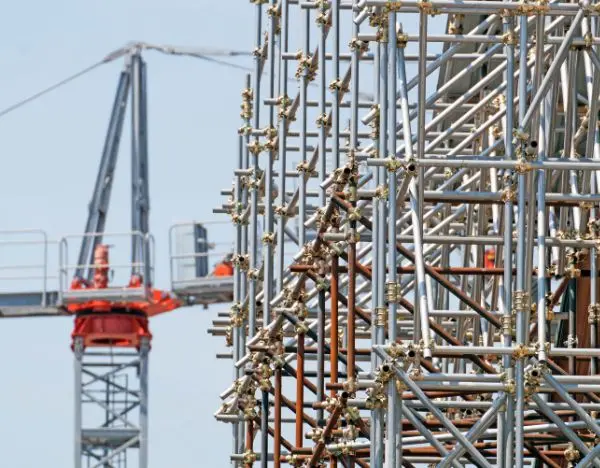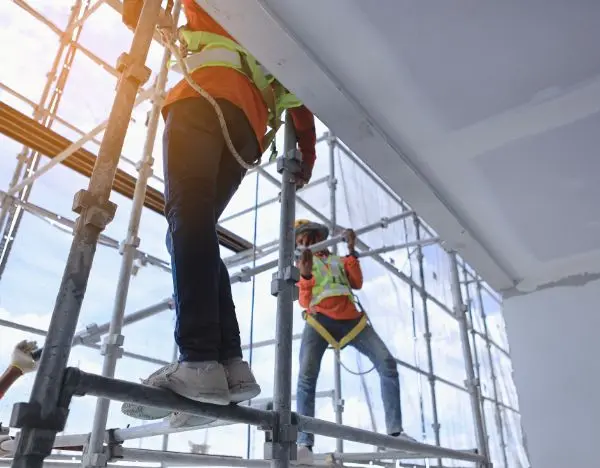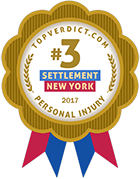Ready to Fight for You
Scaffolding Accident Lawyer
When seeking justice and compensation for scaffolding accidents in New York City, the Law Offices of Mark E. Weinberger P.C. stands as a beacon of hope. With the city’s skyline ever-evolving, construction sites are a common sight, and with them, the risks associated with scaffolding. Our dedicated team of scaffolding accident lawyers understands the complexities of New York’s labor laws and is committed to advocating for the rights of those injured in scaffolding accidents.
PAY NOTHING UNLESS YOU WIN- Contact us today for a FREE consultation and to get your compensation.
What Are Scaffolding Accidents?

Scaffolding accidents refer to incidents that occur in connection with the use of scaffolding structures commonly found at construction sites, building maintenance projects, and various other outdoor work environments. These accidents can happen due to a variety of reasons, including but not limited to:
Structural Failures
This can happen when scaffolding is improperly assembled or constructed with defective materials, leading to collapses or partial failures that can throw workers from significant heights or trap them beneath debris.
Falls from Heights
One of the most common types of scaffolding accidents, where workers fall from elevated platforms due to lack of proper fall protection systems like guardrails, safety nets, or personal fall arrest systems.
Slips, Trips, and Falls
These can occur on the scaffolding itself, caused by slippery surfaces, clutter, or uneven footing.
Struck-by Falling Objects
Workers on or below scaffolding can be injured by tools, materials, or debris falling from the scaffold.
Electrocution
Occurs when scaffolding is erected too close to power lines, or when electrical equipment is used improperly on or near the scaffold.
Inadequate Training and Supervision
Workers may not be properly trained on how to erect, use, and dismantle scaffolding safely, leading to unsafe practices and accidents.
New York’s Labor Law Section 240
New York’s Labor Law Section 240, also known as the “Scaffold Law,” provides unique protections to workers injured in elevation-related accidents, including scaffolding falls. This law holds property owners and contractors liable for accidents caused by safety violations. At the Law Offices of Mark E. Weinberger P.C., we deeply understand this legislation and how it can be leveraged to secure the compensation our clients deserve.
How a Scaffolding Accident Lawyer in NY Can Help
At The Law Offices of Mark E. Weinberger P.C., we understand the devastating impact a scaffolding accident can have on your life and the lives of your loved ones. Our dedicated team is here to help you navigate the aftermath of such an accident with legal guidance and compassionate support. Here’s how we can assist:
Evaluation of Your Case
- Comprehensive Case Assessment: We start by thoroughly evaluating the specifics of your accident to determine the best legal strategy tailored to your unique situation.
- Understanding Your Rights: Our experience e in New York’s labor laws, including the Scaffold Law, ensures you’re fully informed of your rights and the compensation you’re entitled to.
Detailed Investigation and Evidence Gathering
- Accident Scene Analysis: We conduct a meticulous investigation of the accident scene, gathering crucial evidence to support your claim.
- Witness Interviews: Our team of construction accident lawyers will interview witnesses to build a strong foundation for your case.
- Expert Collaboration: We work with construction safety experts, medical professionals, and other specialists to bolster your claim with authoritative testimonies.
Aggressive Representation
- Negotiating with Insurance Companies: Leveraging our negotiation skills, we deal with insurance companies on your behalf to secure a fair settlement.
- Litigation: If a fair settlement cannot be reached, we are prepared to take your case to court, advocating zealously to ensure justice is served.
Maximizing Your Compensation
- Calculating Damages: We meticulously calculate all potential damages to ensure you receive full compensation for medical bills, lost wages, pain and suffering, and any other losses.
- No Recovery, No Fee: Our contingency fee basis means you won’t pay legal fees unless we win your case, ensuring our interests are aligned with achieving the best outcome for you.
Personalized Support and Guidance
- Navigating Medical Care: We guide you through the process of obtaining the necessary medical care and documentation for your injuries.
- Emotional and Legal Support: Understanding the challenges you face, we provide legal representation and emotional support, keeping you informed and comfortable throughout the legal process.
Common Injuries from a Scaffolding Accident

Scaffolding accidents can result in a wide range of injuries, from minor to severe, depending on factors such as the height of the fall, the nature of the accident, and the presence (or absence) of safety equipment. Some of the most common injuries associated with scaffolding accidents include:
Broken Bones
Fractures are common in scaffolding accidents, especially from falls or being struck by falling objects. The severity can range from simple fractures that require minimal treatment to complex fractures needing surgical intervention.
Head Injuries
Traumatic brain injuries (TBIs), including concussions and more severe brain damage, can occur if a worker falls from scaffolding or is hit by a falling object. Head injuries can have long-term cognitive, physical, and emotional effects.
Spinal Cord Injuries
Falls from height can lead to spinal cord injuries, potentially resulting in partial or complete paralysis. These injuries can have life-altering consequences, requiring long-term medical care and assistance.
Cuts and Lacerations
Sharp objects or materials on or around scaffolding can cause cuts and lacerations, which may be superficial or deep, possibly leading to infection if not properly treated.
Internal Injuries
The impact from a fall or being struck by an object can cause internal injuries, including internal bleeding, organ damage, or punctured lungs, which are often life-threatening and require immediate medical attention.
Electrocution
Working near power lines or using electrical equipment on scaffolding can lead to electrocution injuries, ranging from minor shocks to severe burns or even cardiac arrest.
Amputations
In severe cases, scaffolding accidents can result in the traumatic amputation of limbs or the need for surgical amputation due to extensive injury.
Soft Tissue Injuries
Muscles, ligaments, and tendons can be strained, sprained, or torn in scaffolding accidents, leading to pain, swelling, and reduced mobility.
Psychological Trauma
Beyond physical injuries, individuals involved in scaffolding accidents may suffer from psychological trauma, including post-traumatic stress disorder (PTSD), anxiety, and depression, impacting their ability to return to work or carry out daily activities.
The range of potential injuries underscores the importance of strict adherence to safety protocols and the need for comprehensive training and protective measures on construction sites. For those injured in scaffolding accidents, seeking prompt medical attention is crucial, followed by consulting with a legal professional to explore potential avenues for compensation.
What To Do if You Have Been Injured in a Scaffolding Accident
If you have been injured in a scaffolding accident, taking the right steps immediately after the incident can significantly impact your health and your ability to obtain compensation for your injuries. Here’s what you should do:
Seek Medical Attention Immediately
Even if your injuries seem minor, getting a medical evaluation as soon as possible is crucial. Some injuries, especially internal ones, may not be immediately apparent. Documentation of your injuries by a healthcare professional will also be vital evidence if you decide to pursue a legal claim.
Report the Accident
Inform your supervisor, employer, or site manager about the accident right away, in accordance with your company’s reporting procedures. This report should be written in writing, and ensure you keep a copy for your records.
Document Everything
Take detailed notes of the accident, including the date and time, what you did when the accident occurred, how it happened, and any other relevant details. Photographs of the accident scene, your injuries, and anything else that might be related to the incident can be crucial evidence.
Gather Witness Information
If anyone witnessed the accident, get their names and contact information. Witness statements can provide valuable support for your account of the accident.
Keep a Record of Medical Treatments
Document all medical treatments, including doctor visits, physical therapy sessions, medications, and other related expenses. This documentation will be important for proving the extent of your injuries and related expenses.
Follow Your Doctor’s Advice
Adhere to the treatment plan prescribed by your healthcare provider. Failing to follow medical advice can hinder your recovery and affect the outcome of any potential legal claim.
Avoid Social Media
Be cautious about what you post on social media. Insurance companies and defendants might use your social media posts to argue that your injuries are not as severe as claimed.
Consult a Scaffolding Accident Lawyer
Consider consulting with a lawyer with experience in scaffolding accidents and personal injury law in New York. We can provide legal advice tailored to your situation, help you understand your rights, and guide you through seeking compensation.
Do Not Rush into Settlements
Be wary of early settlement offers from insurance companies. These offers may not fully cover the extent of your injuries and future medical needs. A qualified attorney can negotiate to ensure you receive fair compensation.
Maintain Confidentiality
Discuss your case only with your lawyer. Sharing details about your accident or injuries with others could undermine your legal position.
These steps can help protect your health and legal rights after a scaffolding accident. An experienced attorney can provide the support and guidance you need to navigate the aftermath of an accident, including dealing with insurance companies, filing workers’ compensation claims, or pursuing a personal injury lawsuit.
Who is Liable in a Construction Scaffolding Accident?
In a construction scaffolding accident, determining liability can be complex due to the involvement of multiple parties and the specific circumstances of the accident. Liability generally hinges on negligence, failure to adhere to safety standards, and violations of local, state, and federal regulations. Potential liable parties may include:
Employers and Contractors
Employers and contractors are responsible for ensuring a safe working environment, including training workers, providing safety equipment, and adhering to safety protocols. They must comply with Occupational Safety and Health Administration (OSHA) standards and local regulations concerning scaffolding safety.
Property Owners
Property owners may be held liable if their failure to maintain a safe environment contributed to the scaffolding accident. This can depend on the specifics of the contract between the property owner and the construction company.
Scaffolding Companies
If the scaffolding was improperly designed, manufactured, or installed, the company responsible for the scaffolding could be liable for any accidents resulting from these defects.
Equipment Manufacturers
Manufacturers of scaffolding equipment or safety gear can be held liable if an accident was caused by defective products, such as faulty harnesses or scaffolding components.
Third-Party Vendors and Subcontractors
Third parties involved in the construction project, such as subcontractors or equipment rental agencies, may be liable if their actions or negligence contributed to the scaffolding accident.
Determining Liability
To establish liability, it must be shown that:
- The party had a duty of care to the injured individual.
- There was a breach of this duty through negligence or omission.
- The breach of duty directly caused the accident and resulting injuries.
Legal Framework
In New York, the Scaffold Law (Labor Law §240) places strict liability on employers, property owners, and contractors for elevation-related injuries, emphasizing their responsibility to provide safe working conditions. This law makes it easier for injured workers to claim damages for scaffolding accidents without the need to prove negligence.
Why Choose The Law Offices of Mark E. Weinberger P.C.?
Choosing The Law Offices of Mark E. Weinberger P.C. for your scaffolding accident case in New York offers numerous advantages:
- Experienced Legal Team: Our personal injury attorneys possess extensive experience in scaffolding and construction accident cases, ensuring careful handling of your claim.
- Personalized Attention: We offer personalized attention to each client, understanding their unique situation and tailoring our strategy accordingly.
- Proven Track Record: Our firm has a proven track record of securing favorable settlements and verdicts for our clients, demonstrating our commitment to achieving the best possible outcomes.
- In-depth Knowledge of NY Labor Laws: We have experience in New York labor laws, including the Scaffold Law, providing our clients with knowledgeable and effective legal representation.
- No Fee Unless We Win: We operate on a contingency fee basis, meaning you pay nothing unless we win your case, alleviating financial pressure during your recovery.
- Comprehensive Legal Support: From investigation and evidence gathering to negotiation and litigation, we provide comprehensive legal support throughout the entire process.
- Client-Centered Approach: We prioritize the needs and well-being of our clients, offering compassionate support alongside aggressive legal advocacy.
At The Law Offices of Mark E. Weinberger P.C., we are dedicated to fighting for the rights of those injured in scaffolding accidents, striving to ensure they receive the compensation and justice they deserve.
Ready to Claim Justice? Contact Us Today.
If you or a loved one has been injured in a scaffolding accident, it’s time to take action. The Law Offices of Mark E. Weinberger P.C. are here to help you navigate the complexities of your case with experience and compassion. Don’t let the negligence of others impact your life without seeking the justice and compensation you deserve.
Contact us today for a free consultation, and let us advocate for your rights.
Scaffolding Accident Lawyer FAQs
What is a scaffolding accident lawyer?
A scaffolding accident lawyer is a legal professional with experience in representing individuals injured in accidents involving scaffolding. These lawyers know the specific laws and regulations that apply to scaffolding and construction site accidents.
Can I file a lawsuit if I was injured in a scaffolding accident?
Yes, if you were injured in a scaffolding accident due to someone else’s negligence, such as an employer, contractor, or equipment manufacturer, you might be eligible to file a lawsuit to seek compensation for your injuries, lost wages, and other damages.
What types of compensation can I recover in a scaffolding accident claim?
Compensation may include medical expenses, lost wages, loss of earning capacity, pain and suffering, and sometimes punitive damages, depending on the specifics of your case.
How long do I have to file a scaffolding accident lawsuit in New York?
In New York, the statute of limitations for personal injury claims is generally three years from the accident date. However, consulting with a lawyer as soon as possible is important to ensure your rights are protected.
What should I do immediately after a scaffolding accident?
Seek medical attention, report the accident to your employer, document everything (including taking photos of the accident scene and your injuries), gather witness contact information, and consult with a scaffolding accident lawyer.
How does New York’s Scaffold Law affect my scaffolding accident claim?
New York’s Scaffold Law (Labor Law §240) provides special protections for workers injured in height-related accidents, holding employers and property owners strictly liable for safety violations. This law can significantly impact your ability to recover damages.
Do I need a lawyer if I’ve been injured in a scaffolding accident?
While not required, consulting with a lawyer has experience in scaffolding accidents can be crucial. They can help navigate the legal system, deal with insurance companies, and ensure you receive the maximum compensation available under the law.
How much does it cost to hire a scaffolding accident lawyer?
Many scaffolding accident lawyers work on a contingency fee basis, meaning they only get paid if you win your case. The fee is typically a percentage of the settlement or verdict amount.
Can a scaffolding accident lawyer help if I’m a bystander injured in a scaffolding accident?
Yes, if you were injured as a bystander, a scaffolding accident lawyer could help you pursue compensation through a personal injury lawsuit against those responsible for the accident.
How long does a scaffolding accident lawsuit take?
The duration of a scaffolding accident lawsuit can vary widely depending on the case’s complexity, the amount of evidence, and whether the case is settled out of court or goes to trial. Your lawyer can provide a more specific timeline based on your case’s details.
How Can We Help You?
Fields marked with an * are required
"*" indicates required fields




